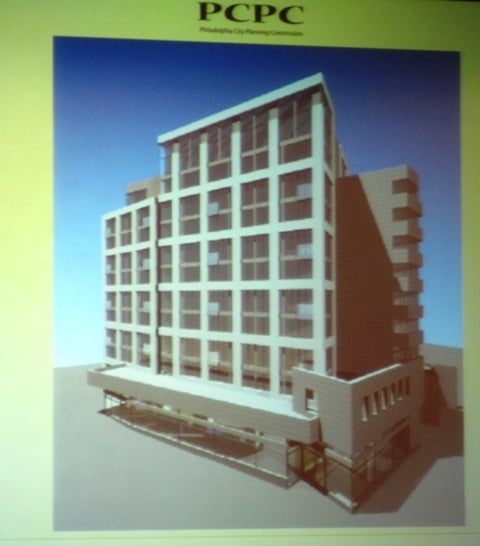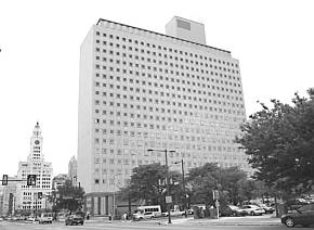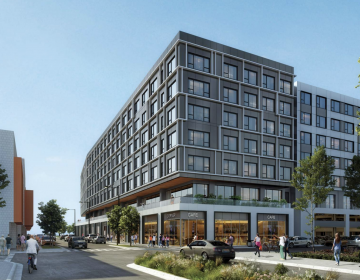Big agenda, tough issues for PCPC

Bart Blatstein’s 2nd and Poplar project
Jan. 20
By Thomas J. Walsh
For PlanPhilly
With attention decidedly elsewhere in the hours leading up to its 1 p.m. commencement, the Philadelphia City Planning Commission forged ahead with its first monthly meeting of 2009, a relatively calm affair compared to a handful of sessions in the second half of 2008, when the public often queued up for input on certain development proposals.
Executive Director Alan Greenberger, in briefing the commission before the main agenda items, reported on the progress being made by the Zoning Code Commission and the outside consultants hired to re-write the city’s zoning code. Excellent progress is under way, he told them. Previous story
One hiccup, though, is the concept of “as-of-right” zoning, also known by the phrase “as a matter of right.” Though it is interpreted differently by different cities, generally it means zoning standards that are determined in advance of development, self-enforcing, and not requiring special approval from, say, the Zoning Board of Adjustment or the Planning Commission. In other words, as-of-right zoning means automatic approval.
“The essential issue that is clearly going to be a source of hot debate and discussion is … how much of the code should be moved to an ‘of-right’ code,” Greenberger said. Put another way, “How much of this code do we want to reflect ‘of-right’ conditions.” He said there would be an extended discussion on the matter at the February 11 meeting of the Zoning Code Commission.
Over three hours, the commission approved every almost every proposal listed on the agenda it posted only a day or two before. (The late notice of its required public posting has become the norm for the agency, and a minor source of annoyance to neighborhood groups.)
Blatstein proposals

Developer Bart Blatstein was again before the commission Tuesday, gaining zoning change nods for his development proposals at the former State Office Building at Broad and Spring Garden streets (apartments and retail) and at 2nd and Poplar in Northern Liberties (an 11-story structure with an 86-unit hotel, ground-floor retail and below-grade parking).
Tower Investments, Blatstein’s development company, bought the State Office Building a year ago for $25.2 million. His proposal was presented to the commission in December as “information-only” and would transform the plain, boxy structure into 474 new living units, including those in a planned new building to eventually be erected beside it along Buttonwood Street, and more than 86,000 square feet of retail space. The change from G2 zoning to C5 was approved.
Ed Panek, chairman of the Logan Square Neighborhood Association, said he was present not to support or oppose the project, but wanted it noted that Blatstein had not yet met with LSNA on the matter. The two agreed that Blatstein would give the association a presentation in February, and Planning Commission Chairman Andrew Altman said approval should not be held up until after that meeting. Purely from a planning perspective, Altman said, “It just seems like a very natural proposal.” Blatstein has said he’ll start work on the building once the state has vacated entirely.
The Poplar Hotel proposal was also given approval for several zoning changes, but drew more discussion. The 11-story, 86-unit extended stay hotel, with ground-floor retail, a take-out restaurant and 86 below-grade parking spots would be situated at 828 N. 2nd Street. Several representatives of the Northern Liberties Neighbors Association were on hand to express caution and opposition. One said the NLNA did not oppose the concept of a hotel or restaurant in principle, but objected to its projected “height and massing,” and requested another month to meet with the developer on it.
An attorney for Blatstein said the project has already been vetted by the city’s Streets Department. As for the NLNA, the lawyer, Ron Patterson of Klehr, Harrison, Harvey, Branzburg & Ellers, said, “We believe they represent only a small part of the consensus of this area.”
“Whatever happened to Mayor Nutter’s vow to make the planning process ‘a rational, transparent and democratic’ one where the community would have a place at the table?” said Deborah Scoblionkov King, speaking as a neighbor and not on behalf of the NLNA. “[The Planning Commission] dismiss some issues as not related to zoning and then to others as adhering to an ‘archaic’ zoning code that has no relevance. It’s ‘meet the new boss – same as the old boss.’”
Blatstein did not talk about development costs or financing during the presentations (a third agenda item – a zoning remapping for Northern Liberties bounded by Girard Avenue, Front, Spring Garden and 6th streets, was tabled), and nor was he asked about it by the commissioners. “I am the equity for all of these projects,” Blatstein said, responding to a query put forward to the commissioners by PlanPhilly (that is, this reporter) regarding general information about where any given developer stands with regard to the financial viability of projects brought before the commission.
In the midst of an incredibly tight, if not still frozen solid, credit market, development projects from San Diego to New England are being delayed or cancelled because of the unavailability of project financing or loans of any kind. However, Altman (who, in addition to his role as head of the Planning Commission, is also the deputy mayor for the Commerce Department), Greenberger and Commissioner Peggy Van Belle all said that requesting even cursory information about the financing of projects being considered for approval is inappropriate.
“The role of the Planning Commission is to take the long view,” Altman said after the meeting adjourned. “It can’t be based on the ups and downs of the development cycles.”
No worries
In any case, Blatstein said he’s in fine shape. During a very short interview after he left the boardroom, the developer cited his 32-year record and said that for the current projects before the commission, he has “no equity partners.” He said he has loans lined up for them, but would not identify the nature of the loans or who was providing them. “Why would I do this?” he shrugged, suggesting that he wouldn’t bother with the planning and zoning processes if he wasn’t confident things would move forward.
“I think that the public deserves to know who is behind these large-scale developments,” said Scoblionkov King. “[Even] the Pennsylvania Gaming Control Board weighs the financial health of the casinos’ investors as a basis for granting approval.”
Blatstein has been active in the Northern Liberties area in recent years, creating plenty of buzz around ambitious projects such as the mixed-use, multi-building endeavor at the site of the old Schmidt’s brewery at 2nd and Girard. He said Tuesday that he has $100 million invested in seven projects currently under construction there, all to be finished by spring.
“There’s a balance to be struck there,” said Craig Schelter, founder of Schelter & Associates, a planning and development management firm. “On the one hand it’s appropriate,” he said, especially with new processes regarding time limits (or “sunset clauses”) put on certain projects. “On the other hand, developers often need an indication of public support if they are going to get financing.”
As for identifying tenants, Schelter, who is also the former head of the Planning Commission and a veteran of the Philadelphia Industrial Development Corp., said that hotel companies are notoriously fickle and often play developers off each other.
Altman said he saw no exceptions to the general rule of steering clear of the money side of things, even if a given project is delayed for a long period of time, or drastically changes in terms of scope. And he repeated that the public should not expect to hear questions or discussions at Planning Commission meetings about overall development costs, or financial expectations in terms of a project’s timing, or a given developer’s track record, no matter the circumstances.
2116 Chestnut
An “information only” presentation was given by the John Buck Co. for what is being called the 2116 Chestnut Street Residential Development on Rittenhouse Square, bounded by Chestnut, Samson, Van Pelt and 22nd streets.
In addition to what were described as 329 apartments to be comprised mostly of one-bedroom and studio apartments, a new state-of-the-art facility for the Sidney Hillman Medical Center is part of the development plans. The Sidney Hillman center has been in the neighborhood for about 60 years.
Germantown & Nicetown
Commission city planner and staffer Jennifer Barr kicked things off with a skillful, deliberate presentation of a project she’s been working on for a while now, the Germantown and Nicetown Transit-Oriented Neighborhood Plan that started in mid-2007. It’s being funded by transportation-oriented community development grants and matching “in-kind” services from the city.
Larger than the “technical boundaries” of the two neighborhoods, it is targeted at improving and increasing the use of five train stations and associated redevelopment efforts. The stations are: Queen Lane Station to the south, Chelten Avenue Station to the west, Germantown Station to the north, Wister Station to the northeast, Fisher Station to the east, and Wayne Junction Station – one the region’s busiest public transportation hubs – to the southeast.
At Wayne Junction Station, the emphasis will be on parking, circulation, and transit-oriented redevelopment. Barr said there have been “numerous conversations with the [Philadelphia Industrial Development Corp.] and the [Redevelopment Authority] regarding land acquisition.
For the Queen Lane Apartments (Pulaski and Queen Lane), “we recommend that high-rise be demolished,” Barr said, explaining that the Philadelphia Housing Authority had been consulted on it, and that the apartments would be replaced with in-fill units and a mid-rise.
At Chelten and Germantown avenues, the idea is to extend activity from Chelten Station to Germantown Station, redeveloping and correcting past planning mistakes like the Maplewood Mall, opening it up to traffic for starters.
“I’m very excited about this project,” said Natalia Olson de Savyckyj, a commissioner and a planner with the Delaware Valley Regional Planning Commission. “I think that everything should be tied to transportation.” Olson de Savyckyj wondered if the neighbors have expressed density concerns, but Barr said not at all. “There’s a lot of feeling that Germantown needs momentum,” Barr said. “There are lots of vacant parcels and houses.”
Contact the reporter at www.ThomasJWalsh.info.
ON THE WEB:
Germantown and Nicetown Transit-Oriented Neighborhood Plan
WHYY is your source for fact-based, in-depth journalism and information. As a nonprofit organization, we rely on financial support from readers like you. Please give today.





